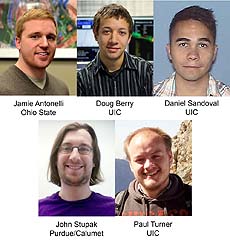Two Higgs are better than one
 |
| Finding pairs of Higgs bosons might be a path to discovering something entirely new. Because Higgs bosons are unstable, what experimenters really do is look for the presence of four b (bottom) quarks.
|
It seems like only yesterday that scientists were combing diligently through their data looking for single Higgs bosons. Now that we know not only that Higgs bosons exist, but also their mass, scientists have been looking for pairs of Higgs bosons, which could be useful in searching for new physics phenomena.
For example, in an attempt to understand why gravity is so much weaker than other forces, scientists are using Higgs bosons to investigate the idea that there are more dimensions of space than the familiar three. (If you're interested in a little more details of the basic idea, take a look at this video.)
One class of the extra-dimension model predicts the existence of heavy gravitons. (The physics-savvy reader may wonder about the idea of heavy gravitons when gravitons are supposed to be massless. If extra dimensions exist, then it is possible that at least some forms of gravitons might be massive.)
Heavy gravitons would decay, and one of the possible ways in which they could decay would be into two Higgs bosons. Higgs bosons are themselves unstable and they also decay most commonly into pairs of bottom quarks, or b quarks. CMS scientists searched for events in which four bottom quarks were produced, two from each of two Higgs bosons. This is a difficult analysis given the LHC can easily generate collisions in which four quarks (and even four bottom quarks in particular) are produced.
After carefully inspecting the data, what scientists found was completely consistent with the predictions of the Standard Model: They found no heavy gravitons this time around. However, the LHC will resume operations in the near future, and researchers will use the increased collision energy to look for even heavier gravitons.
—Don Lincoln
 |
| These physicists contributed to this analysis. |
 |
| These physicists and technical professionals are playing a crucial role in testing prototype modules for the CMS forward silicon pixel detector upgrade.
|
|